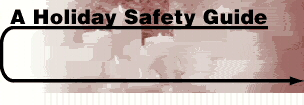 |
|||
 |
| |||||||||||||||||||
| Family,
Home and Community | ||
| Free
E-mail Alert |
Live Police
Scanners |
Forums |
|
Unsafe Toys Lurk on Store Shelves Unwrapping This Year's Lists of Harmful Children's Products Dec. 8, 1999 By Joan Lippert
In 1998, more than 153,000 children were treated in hospital emergency rooms for toy-related injuries, according to the U.S. Consumer Product Safety Commission (CPSC) in Washington; 14 children died as a result of their injuries. Choking (typically on balloons and small parts), drowning (when toys that are ridden are driven into water) and strangulation (from cords more than 12 inches long) are leading causes of death in children from toys. No matter how vigilant the public is, dangerous toys and games still seem to make their way to the shelves each year. 'Dive sticks' and age labels "[Some] toys are dangerous by design and end up being recalled," CPSC spokeswoman Jane Francis said. This was the case with colorful "dive sticks," weighted cylinders that stood on end when tossed into a pool. Children would dive in to retrieve the 4- to 8-inch-long, 1-inch-diameter toys. The sticks caused at least six vaginal and rectal impalements and one facial injury in children 6 to 9 years old, the CPSC said. Consequently, the agency recalled more than 19 million dive sticks in June. Many people mistakenly believe that age labels on toys rate its interest to that age group, but they're actually safety warnings, said Rachel Weintraub, staff attorney with the Public Interest Research Group (PIRG) in Washington. "To prevent toy-related injuries and deaths, caregivers should read the age-appropriate labels when choosing toys. This information could save a child's life," Francis said. "[Toys] intended for older children often have small parts that pose a choking hazard to younger siblings," she said. In its 14th annual report on toy safety, Trouble in Toyland, PIRG claimed that some toy manufacturers were trying to circumvent the CPSC ban on small parts or small balls in toys intended for children younger than 3 years old. "[In] a number of instances, we've felt that toys have been mislabeled," Weintraub said. Families fighting back
As the Pokemon phenomenon continues to steamroll on the success of last month's record-setting opening of Pokemon: The First Movie, the family of an autistic boy, 7, who choked to death on a Pokemon Power Bouncer filed a $100 million lawsuit against Hasbro Inc. and Toys R Us. The wrongful death suit alleges the clear rubber ball with a cartoon character inside was unsafe and not marked with proper warnings. Hasbro said in a statement that the toy met all federal regulations, and pointed out that some 8 million balls have been sold worldwide without a similar incident. Plastic toys a cancer risk? Citing safety concerns, the European Union's Scientific Committee for Toxicity, Ecotoxicity and Environment recently voted unanimously to ban a class of chemical agents that soften plastic used to make baby rattles, pacifiers and teething toys. The committee maintained that these chemicals, phthalates, could cause liver, kidney and testicular damage in babies who suck and chew on vinyl toys. This is the latest salvo in a debate that has been raging since the PIRG sounded the alarm about phthalates in soft polyvinyl chloride (PVC) toys last year. "Unfortunately, labels don't say whether a toy contains phthalates," said Weintraub. PIRG is calling for the CPSC to ban phthalates from toys intended for children under 3 years of age. The Toy Manufacturers of America Inc., which represents 250 producers and importers of toys, is "still waiting for valid scientific proof that these toys are dangerous," said spokeswoman Diane Cardinale. The industry group's position is supported by reports from the American Council on Science and Health, the CPSC and the Food and Drug Administration that concluded phthalates are not harmful to children and adults. Nonetheless, Mattel, Gerber, Little Tykes and other manufacturers are phasing out the use of phthalates in their teething toys, and major retail chains have taken these products off the shelves. For its part, the Toy Industries of Europe asked the EU committee to study the issue further; the industry group offered to stop selling teething rings that contain phthalates in the meantime. Choosing safe toys To avoid giving an unsafe toy this holiday season, follow these guidelines from the National SafeKids Campaign, the CPSC, and the PIRG:
To find out whether a toy on your shopping list or already in your child's toy box has been recalled by the CPSC or is on a "bad toys" list, click on the links below:
Finally, steer clear of thrift store "bargains." Major stores are conscientious about removing recalled toys -- for example, in a 1998 PIRG toy safety report noted that when one of its tried to pay for a recalled toy at Toys R Us that had not yet been removed from the shelves, it wouldn't ring up. In contrast, earlier this year, a CPSC survey of thrift stores suggested most were selling banned and recalled unsafe toys. Joan Lippert is an
APBnews.com correspondent in New York. The Associated Press contributed to
this report.
|
| |||||||||||||||||||||||||||||||||||||||
|
| ||||||







